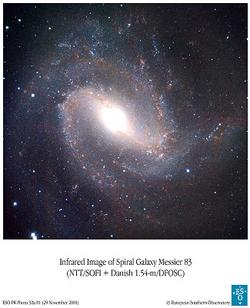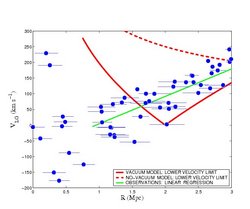

|
The Universe is not only getting bigger, it also seems to be accelerating, implying that a new form of energy, dubbed "dark energy", operates on the Universe's very largest scales. The cosmological consequences of dark energy are well established via many different observations of objects at large distances from us. But there is also an effect of the dark energy quite close by, as astronomers Arthur Chernin, Pekka Teerikorpi and Yuri Baryshev, realised when they compared the balance of the inwardly-acting gravitational force around small galaxy groups with the outwardly-acting effects of dark energy. They discovered that the motions of galaxies in regions around small groups of galaxies appear to be affected by dark energy, and demonstrated the effects could be seen very close to home in our own Local Group. One of the effects of dark energy is that the velocities of galaxies around such groups deviates very little from the general Hubble expansion. In this picture, the Hubble flow is termed 'cool'. An important test of the theory is that the same effects would be seen in other groups. Chernin and collaborators (including Mauri Valtonen and Pekka Teerikorpi of Tuorla Observatory) have now studied the nearby complex of galaxies which form the Centaurus A and M83 groups. Distances to the galaxies had been obtained with high precesion using Hubble Space Telescope by Igor Karachentsev and collaborators. They studied the motions of almost 100 galaxies within some 12 million light years of the center of the system. They discovered the same 'cool' flow in the Hubble field -- in which galaxies deviate very little from the Hubble flow, just as was seen in the Local Group. The work leads to the suggestion that the natural scale for objects in the universe is a so-called "Hubble Cell", which have radii defined by a balance between gravitating matter and dark energy effects. In CenA/M83, the balance point between gravitating matter and dark energy is a roughly spherical region around the complex with a radius of about 6 million light years. The Local Group of galaxies has a similar balance point, but because it is less massive tha CenA/M83, it is closer in, at about 4 million light years radius. Hubble cells may be the natural building blocks of the Universe, and may cover observed space almost entirely. A preprint of this work is available here. |

An infrared image of the nearby galaxy M83, which lies at the
center of one part of the mass concentration analysed in the
study. Credit: European Southern Observatory 
The plot shows the Hubble law in the environment of the M83 and Centaurus A galaxy groups, with distance from the center of the system plotted against the velocities of the galaxy relative to the systemic velocity. Beyond some 2 Mpc (6 million light years) from the center of the system. the velocities and distances fall on a tight relationship, as expected if dark energy has affected the motions of these galaxies. The solid red curve shows a lower limit for the velocities of these galaxies, from theoretical work on dark energy and gravitating matter in small galaxy groups. Inside 2 Mpc, the motions of the galaxies are dominated by their own gravity, and the scatter in the velocities increases considerably. The expectation for the behaviour of the velocities in a model in which dark energy is not included in the equations of motions is shown by the dashed red line, and is a poor fit to the data. Plot credit: Arthur Chernin. Larger image available here. |